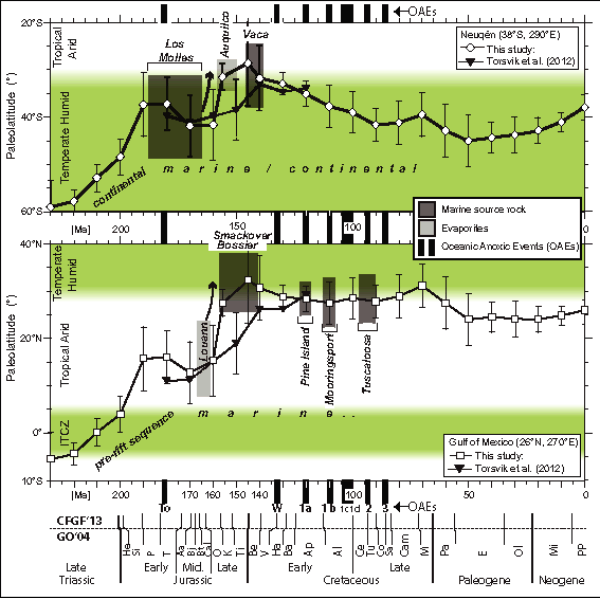
Figure 3.
In upper panel, the paleolatitudinal evolution of the Neuqén Basin in Argentina (38°S, 290°E) and in lower panel of the Gulf of Mexico offshore Texas (26°N, 270°E) calculated from the APW path of Table 1 (in South American and North American coordinates, respectively). Errors in age (not shown to enhance visual clarity of diagram) are ±10 m.y. except for paleolatitudes at 145 and 156 Ma with errors of ±5 and ±1.6 m.y., respectively; errors in paleolatitude (shown as vertical bars) are equal to ± A95 (cone of 95% confidence of mean paleomagnetic pole). The black arrows highlight the latitudinal drift associated with the Jurassic polar shift. Included in both diagrams are the paleolatitudes predicted from the Torsvik et al. (2012) APW path for 180–120 Ma (black triangles) with vertical error bar at 150 Ma. The names of main source and seal rock formations discussed in the text are also reported (e.g., Los Molles, Auquilco, Vaca [ = Vaca Muerta], Louann, Smackover). Continental, marine—continental or marine sedimentation. Oceanic Anoxic Events (OAEs): To—“Posidonienschiefer” (Toarcian); W—“Weissert” (Valanginian–Hauterivian); 1a—“Selli” (Early Aptian); 1b—“Paquier” (Late Aptian–Early Albian); 1c—“Toolebuc” (Late Albian); 1d—“Breistroffer” (Late Albian); 2—“Bonarelli” (Cenomanian–Turonian boundary); and 3 (Coniacian–Santonian) (Cronin, 2010). CFGF’13—time scale of Cohen et al. (2013); GO’04—time scale of Gradstein and Ogg (2004). ITCZ—Intertropical Convergence Zone; He—Hettangian; Si—Sinemurian; P—Pliensbachian; T—Toarcian; Aa—Aalenian; Bj—Bajocian; Bt—Bathonian; Cal—Callovian; O—Oxfordian; K—Kimmeridgian; Ti—Tithonian; Be—Berriasian; V—Valanginian; Ha—Hauterivian; Ba—Barremian; Ap—Aptian; Al—Albian; Ce—Cenomanian; Tu—Turonian; Co—Coniacian; Sa—Santonian; Cam—Campanian; M—Maastrichtian; Pa—Paleocene; E—Eocene; Ol—Oligocene; Mi—Miocene; PP—Pliocene–Pleistocene.